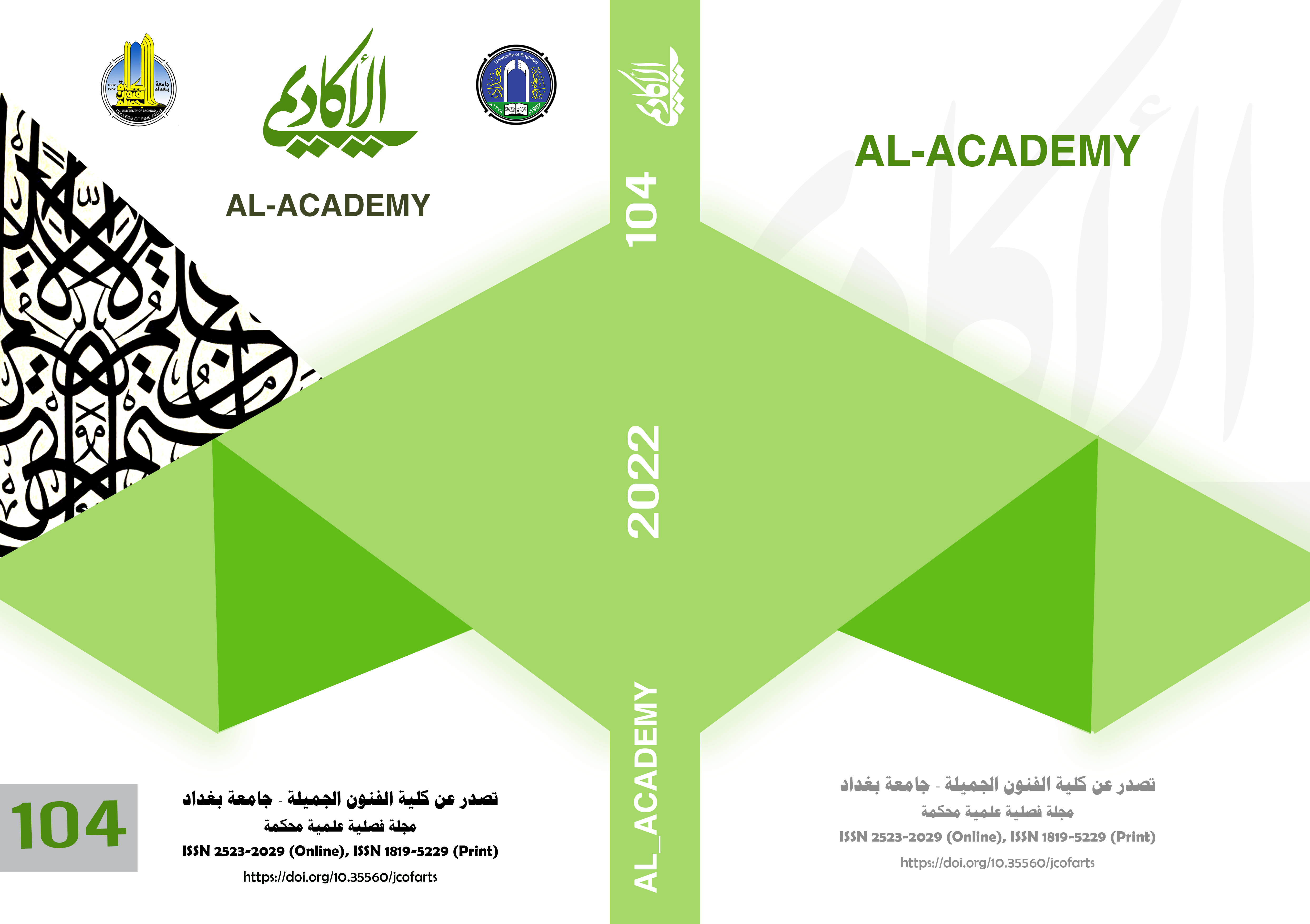Semantic reflection of rhetorical expression in brand design
DOI:
https://doi.org/10.35560/jcofarts104/91-114Keywords:
Expression, reflection, signification, rhetoricAbstract
The rhetoric is concerned with the expressive emphasis of things, the science of the statement takes the treatment of graphic images and rhetorical fiction, and in the science of the exquisite dealing with the study of verbal and moral improvements, and in the science of meanings took all related to compositions and methods, and these vocabulary entered into the field of art and its branches largely, especially in the uncle and art of design because it has a major role in including a lot of biological functions with a deep meaning of its comprehensiveness on the multiplicity of real meanings characterized by suggestive and important and semantics refer to the recipient in the research to refer to the recipient The discovery of the internal contents, meanings and meanings of speech, which came through the technical, intellectual, expressive, functional and aesthetic orientation to present multiple show options consistent with the design idea. This research highlighted the extent of the semantic reflection of the brand's rhetorical expression and the presentation of the research problem was based on the question: What is the semantic reflection of rhetorical expression in brand design?
The research included four chapters, from which the theoretical framework identified two theories and addressed the following topics: (the intellectual and philosophical vision of the concept of significance, the rhetorical, semantic and deliberative concept of expression in the brand, and the methods of reflecting the expressive significance in the design of the brand), and then addressed the research indicators that produced the theoretical framework, including the semantic interaction of rhetorical expression, representing a structure loaded with formal rather than verbal meanings, crystallized in the embodiment of expressive rhetoric in the design of the brand. The third chapter dealt with the procedures he carried out, which included the methodology of research by selecting the descriptive approach for the purposes of analysis, adopting the method of the sample intended in the selection of sample models, if (5) models were chosen from the research community and by (25%) of the original community, and then singled out the fourth chapter to present the results, discuss them and conclusions, as it came from: Key words (Expression, Rhetorical, reflectance, Significance)
1. The eloquence of expression was shown by the suggestive significance of the movement of the arrow, which represents a smile that represents the satisfaction and joy of the consumer, as it was achieved by that indication the strength of the indicator represented by the smiley arrow under the written text as in the models (1.5), but the results include:
1. Rhetorical expression is not a compilation of different elements or multiple words in meaning, but rather a mediator who engages and interacts with elements so that their qualities are acquired from each other as a result of the interaction based on organization and order of the elements of the idea.
References
Abd Al Majid Al Zarrouqi. (2010). Methodology or legal rhetoric expressing thinking . Beirut Lebanon: The House of Scientific Books.
aben manzoor. (2007). The dictionary of the tongue of the Arabs. Beirut Lebanon: Pen Library for Publishing and Distribution.
Al-Bustani, F. A. (1986). Student Upholstery. Beirut Lebanon: Mashreq Publishing and Distribution.
Ali bin Mohammed Al-Sayed Al-Sharif Al-Jarjani. (1993). Dictionary of definitions investigation and study of Mohammed Siddiq Al-Manshawi. Beirut Lebanon: Al-Fadhila Publishing and Distribution House.
Alloush, S. (1985). Dictionary of contemporary literary terms. Beirut Lebanon: The Lebanese Book House for Publishing and Distribution.
Al-Tafazani, S. e. (D.T). Summary explanations. Beirut Lebanon : Scientific Book House.
Alzamakhshari, A. a.-Q. (1987). The basis of rhetoric. Beirut Lebanon: Issued for distribution and publication.
Eid, K. (1978). Philosophy of art and literature. Tunisia: Al Arabiya Book And Distribution House.
Eno Dozi. (1988). The dialectic of sociology between symbol and signal. Baghdad Iraq: House of Public Cultural Affairs.
George Sentiana. (D.T). Sense of beauty Ter: Mohamed Mustafa. Cairo Egypt: The Anglo-Egyptian Library for Publishing and Distribution.
Hamed Aouni. (2018). Clear approach to rhetoric. . Cairo Egypt: Al-Azhar Heritage Library .
Ibrahim Medkur. (1979). Dictionary of Arabic terms in language and literature. . Beirut Lebanon: Orient Printing and Distribution House.
Ibrahim, A. (1995). Knowing the other is an introduction to modern monetary approaches. Beirut Lebanon: Arab Cultural Center.
Jarman., C. (1997). Semantics Investigation: Nour Al-Huda Lotchen. Tripoli, Libya: National Book House for Publishing and Distribution.
Mohamed Fattah. (1985). Analysis of poetic discourse. Beirut Lebanon: Enlightenment House for Printing and Publishing.
Mohammed Al-Grafi. (2002). Reading in Visual Semiology . Baghdad, Iraq: The World of Thought Magazine, 1 volume 32.
Mohammed Sharif Sabri. (2005). Entrance to Semiotica Advertising. Cairo Egypt: Helwan University .
Rawia Abdel Moneim. (1987). Aesthetic values. Alexandria Egypt: University Knowledge Publishing and Distribution House.
saliba, j. (1979). Philosophical Dictionary. Beirut Lebanon: Lebanese Book Publishing and Distribution House .
Sedgwick, A. P. (2009). Encyclopedia of Cultural Theory. Hana Al-Jawhari's translation: National Translation Center.
Shirin Ihsan Sherzad. (1985). Principles in art and architecture. Baghdad, Iraq: Knowledge Publishing and Distribution House.
Tabana, B. (1997). Arabic rhetoric dictionary. Cairo Egypt: Dar Ibn Hazem .
Yassin, A. I. (2014). Professional design. Jordan Amman: The World of Culture Publishing and Distribution House.
Youssef is the son of Abu Bakr al-Sakaki. (1987). The key to science. Beirut Lebanon: Scientific Books House .
Zeid, Q. S. (2014). An entrance to the Semiotic. Cairo Egypt: Enlightenment House for Printing and Publishing .
Zuhair Abdul Sahib. (2000). Shape systems in Sumerian art. Baghdad Iraq: Published search. The Iraqi Ministry of Culture.
Downloads
Published
Issue
Section
License
Copyright (c) 2022 foad Ahmed Shalal Al-Sammaraee , Wissam Abdul Aziz

This work is licensed under a Creative Commons Attribution 4.0 International License.













